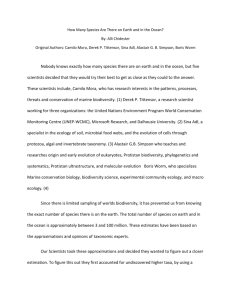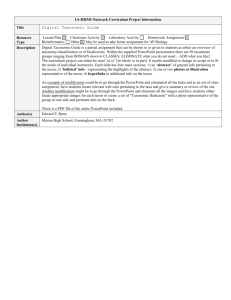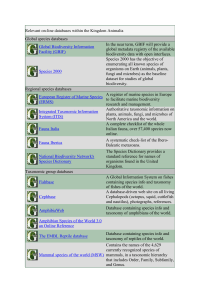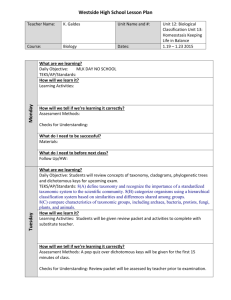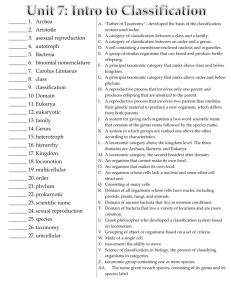English - Convention on Biological Diversity
advertisement
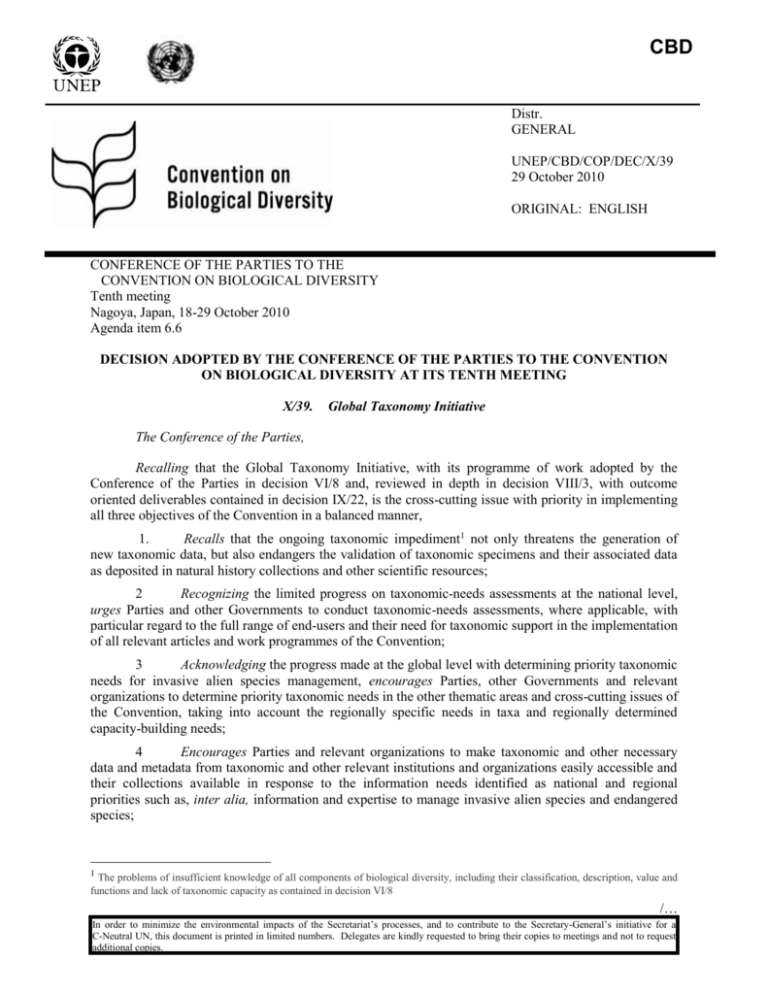
CBD Distr. GENERAL UNEP/CBD/COP/DEC/X/39 29 October 2010 ORIGINAL: ENGLISH CONFERENCE OF THE PARTIES TO THE CONVENTION ON BIOLOGICAL DIVERSITY Tenth meeting Nagoya, Japan, 18-29 October 2010 Agenda item 6.6 DECISION ADOPTED BY THE CONFERENCE OF THE PARTIES TO THE CONVENTION ON BIOLOGICAL DIVERSITY AT ITS TENTH MEETING X/39. Global Taxonomy Initiative The Conference of the Parties, Recalling that the Global Taxonomy Initiative, with its programme of work adopted by the Conference of the Parties in decision VI/8 and, reviewed in depth in decision VIII/3, with outcome oriented deliverables contained in decision IX/22, is the cross-cutting issue with priority in implementing all three objectives of the Convention in a balanced manner, 1. Recalls that the ongoing taxonomic impediment1 not only threatens the generation of new taxonomic data, but also endangers the validation of taxonomic specimens and their associated data as deposited in natural history collections and other scientific resources; 2 Recognizing the limited progress on taxonomic-needs assessments at the national level, urges Parties and other Governments to conduct taxonomic-needs assessments, where applicable, with particular regard to the full range of end-users and their need for taxonomic support in the implementation of all relevant articles and work programmes of the Convention; 3 Acknowledging the progress made at the global level with determining priority taxonomic needs for invasive alien species management, encourages Parties, other Governments and relevant organizations to determine priority taxonomic needs in the other thematic areas and cross-cutting issues of the Convention, taking into account the regionally specific needs in taxa and regionally determined capacity-building needs; 4 Encourages Parties and relevant organizations to make taxonomic and other necessary data and metadata from taxonomic and other relevant institutions and organizations easily accessible and their collections available in response to the information needs identified as national and regional priorities such as, inter alia, information and expertise to manage invasive alien species and endangered species; 1 The problems of insufficient knowledge of all components of biological diversity, including their classification, description, value and functions and lack of taxonomic capacity as contained in decision VI/8 /… In order to minimize the environmental impacts of the Secretariat’s processes, and to contribute to the Secretary-General’s initiative for a C-Neutral UN, this document is printed in limited numbers. Delegates are kindly requested to bring their copies to meetings and not to request additional copies. UNEP/CBD/COP/DEC/X/39 Page 2 5. Recognizing the need for better and more comprehensive data of species distribution at bioregional scale, urges Parties and invites other Governments and organizations, to better coordinate their taxonomic research in biogeographic regions, and to share and exchange, new and existing information; 6. Further urges Parties and invites other Governments and organizations to increase the knowledge base on ecological range and the condition of the species in order to better meet the user-needs in respect of bioindication of ecological health; 7. Requests the Executive Secretary with the assistance of the Coordination Mechanism for the Global Taxonomy Initiative and in collaboration with relevant international organizations, to hold capacity-building training workshops in all subregions and regions as needed; 8. Urges Parties and invites related project proposals relevant to their collaboration with national, regional and process of project funding by the Global funding; other Governments to endorse Global Taxonomy Initiativenational biodiversity strategies and action plans prepared in global partner organizations and networks, to facilitate the Environment Facility and through other relevant sources of 9. Urges Parties and invites other Governments to facilitate the development of the capacity, in collaboration with global, regional and subregional networks, as needed in: (a) The use of shareable taxonomic knowledge, and associated materials, by enhancing the management and use of in-country collections of referenced specimens, subject to the provisions of Article 15 of the Convention; (b) Molecular techniques commonly used in taxonomy, such as DNA barcoding among others; (c) taxonomists; Training courses both for the users of taxonomic information and for young professional (d) Scientific collections in developing countries, particularly the least developed countries and small island developing states among them, and countries with economies in transition; 10. Recognizing the importance of exchange of taxonomic voucher specimens for noncommercial biodiversity research, encourages Parties, other Governments and organizations to find ways of facilitating and benefiting from regional and subregional scientific and technical collaborations in accordance with relevant national legislation and relevant requirements where applicable with due regard for the need to address changes in use and intent other than taxonomic and subject to the outcomes of the negotiation on the international regime on access and benefit-sharing under the Convention; 11 Recognizing that the number of professional taxonomists is predicted to decrease and that the rapid accumulation of information in DNA sequences will require an expansion of taxonomic expertise to reliably identify the taxa from which the sequences derive; allowing potential of new technologies to be maximize for a wide range of biodiversity assessments, encourages Parties and other Governments to enhance the activities of institutions related to taxonomy to provide job opportunities and incentives for young taxonomists and to strengthen the taxonomic capacity to conduct appropriate training for parataxonomists and relevant end-users of taxonomy at national, regional and global levels; 12. Invites Parties, other Governments and international and funding organizations to carry out implementation of the programme of work for the Global Taxonomy Initiative with special attention to national and regional inventories of all organisms, i.e. plants, animals and microorganisms; 13. Further recognizing that taxonomic capacity is crucial for the implementation of all relevant articles and work programmes of the Convention and that the taxonomic capacity to inventory and monitor biodiversity, including the use of new technologies, such as DNA barcoding and other /... UNEP/CBD/COP/DEC/X/39 Page 3 relevant information technology is not adequate in many parts of the world, invites the Global Environment Facility, Parties, other Governments, and other international and funding organizations to put higher priority for funding to GTI proposals; 14. Welcoming the progress on the establishment of a Special Trust Fund for the Global Taxonomy Initiative and acknowledging the work of BioNET-INTERNATIONAL and relevant networks and organizations and Parties contributing to the development and promotion of the sponsorship strategy and global campaign, as elaborated in the progress report on the establishment of a special fund for the Global Taxonomy Initiative:2 (a) Invites Parties and other Governments and organizations to respond urgently to make the trust fund operational before the eleventh meeting of the Conference of the Parties; (b) Requests the Executive Secretary, in accordance with decision IX/22 to propose the formal constitution of a steering committee reflecting regional balance and other appropriate expertise to facilitate identification of suitable funding sources and assist the operationalization of the Special Fund taking into account the suggestions included in the progress report; 15. Welcomes the section on taxonomy as part of the statement and recommendation from UNESCO International Year of Biodiversity Science Policy Conference, held at UNESCO Headquarters, Paris from 25 to 29 January 2010 and urges Parties and invites other Governments and relevant organizations to support and implement, as appropriate, in accordance with all three objectives of the Convention on Biological Diversity and, where applicable, with prior informed consent and/or approval and involvement of indigenous and local communities, as well as relevant national legislation, the following recommendations for scaling up and sustaining taxonomy resulting from this Conference: (a) Supporting indigenous and local communities in capturing and preserving their taxonomic knowledge; (b) Applying cybertaxonomy, molecular and other innovative approaches to accelerate the taxonomic workflow of discovery and description; (c) Using digital and molecular infrastructure tools to integrate taxonomic data with other types of life science information, thus also broadening the products available to support identification and other services; (d) Prioritization of taxonomic efforts according to scientific knowledge gaps and user needs; (e) Making communication and outreach standard practice, and using Internet media platforms to reach the public and others; (f) Training a new generation of taxonomists, able to work flexibly and collaboratively and taking stock of new and emerging technologies and tools; (g) Appreciating the valuable contributions of taxonomy and recognizing it as a branch of cutting-edge science; 16. Requests the Executive Secretary in consultation with Coordination Mechanism for the Global Taxonomy Initiative, national focal points for the Initiative and relevant institutions, bodies and organizations, to develop a comprehensive capacity-building strategy for the Global Taxonomy Initiative 2 UNEP/CBD/CO/10/INF/35. /… UNEP/CBD/COP/DEC/X/39 Page 4 at global and regional levels that addresses the Strategic Plan for Biodiversity 2011-2020, taking into account: (a) The need for consistency between the planned activities relevant to capacity building in programme of work for the Global Taxonomy Initiative and the outcome oriented deliverables contained in decision IX/22; (b) Taxonomic needs and capacities as already reported; (c) The relevant stakeholders and resources required as well as possible funding mechanisms; and (d) Taxonomic needs and priorities for the thematic areas and other cross-cutting issues for the Convention, in particular for the work on protected areas and invasive alien species; and present the draft progress report to the Conference of the Parties at its eleventh meeting, and requests the Subsidiary Body on Scientific, Technical and Technological Advice to review the draft strategy prior to the eleventh meeting of the Conference of the Parties; 17. Requests the Executive Secretary to develop a standard format for taxonomic needs and capacity assessments for use by Parties; 18. Requests the Executive Secretary in consultation with the Coordination Mechanism for Global Taxonomy Initiative and the ad hoc technical expert group on post-2010 indicators to consider developing an indicator in order to assess the progress on the implementation of the programme of work for the Initiative as needed. -----


